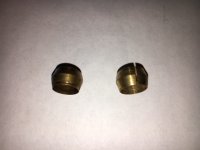The directional signals on my '60 BN7 have quit. Quit one time, briefly resumed function, then quit for good. Clues? I've been through the usual wiring/bulb checks w/o any resolution.
Turning to the Haynes manual, p. 166, item 29, flasher circuit, I ran tests b and c with the ignition on and the directional lever turned. I got no result, which the manual tells me suggests the flasher is not dead.
I also put a test light on all three flasher poles, ignition on, directional lever tried both on an off, and got a test light on each. Unfortunately, my 8-pole brake switch relay wiring bears look [no?] resemblance to the one in the Haynes manual, making understanding the wiring pretty challenging. I've also consulted the illustrations Norman Nock's "Tech Talk", p. 280.
Since the signals have always worked with the existing wiring connections, something else must be involved. Any suggestions?
Turning to the Haynes manual, p. 166, item 29, flasher circuit, I ran tests b and c with the ignition on and the directional lever turned. I got no result, which the manual tells me suggests the flasher is not dead.
I also put a test light on all three flasher poles, ignition on, directional lever tried both on an off, and got a test light on each. Unfortunately, my 8-pole brake switch relay wiring bears look [no?] resemblance to the one in the Haynes manual, making understanding the wiring pretty challenging. I've also consulted the illustrations Norman Nock's "Tech Talk", p. 280.
Since the signals have always worked with the existing wiring connections, something else must be involved. Any suggestions?

 Hi Guest!
Hi Guest!

 smilie in place of the real @
smilie in place of the real @
 Pretty Please - add it to our Events forum(s) and add to the calendar! >>
Pretty Please - add it to our Events forum(s) and add to the calendar! >> 


